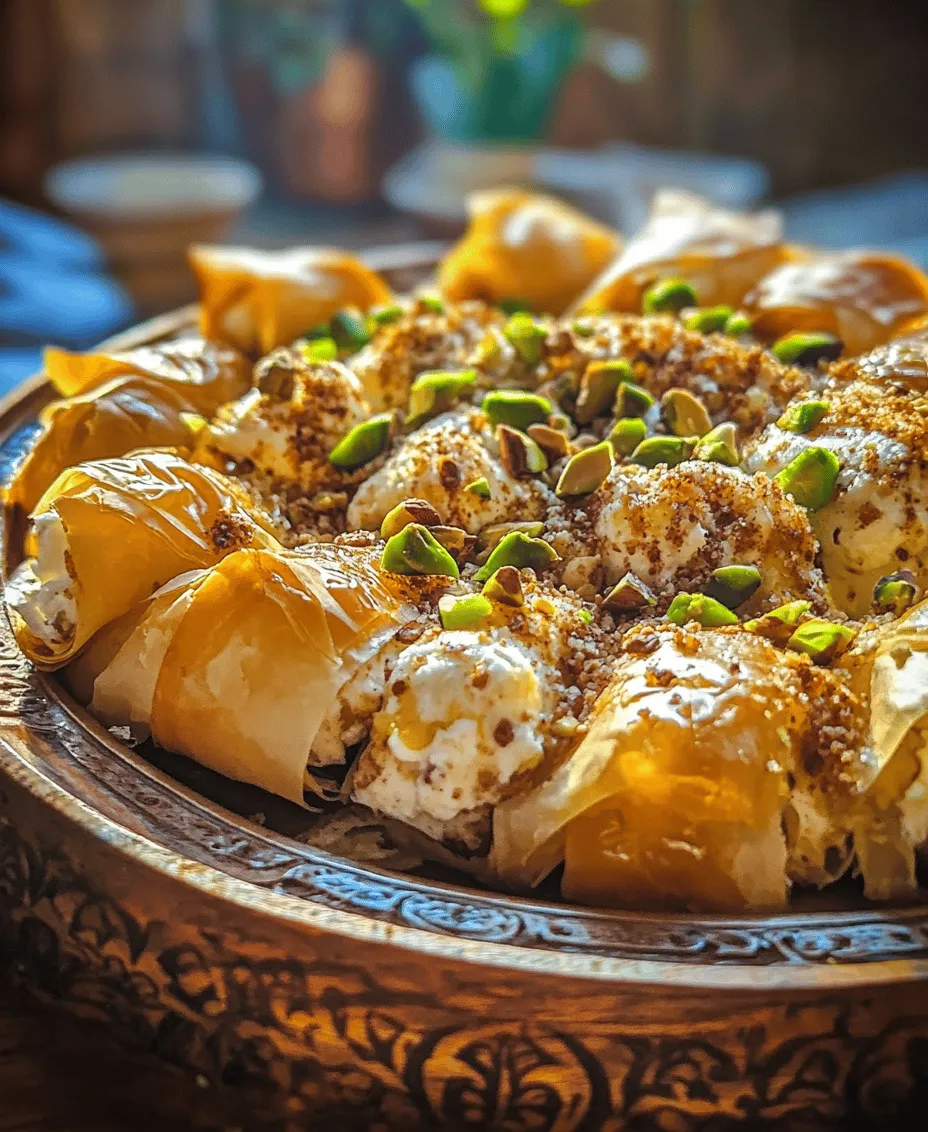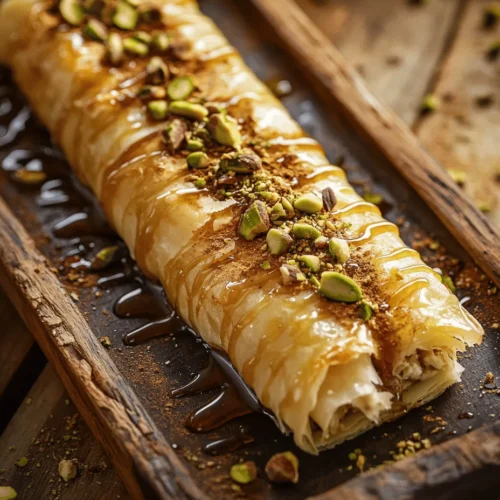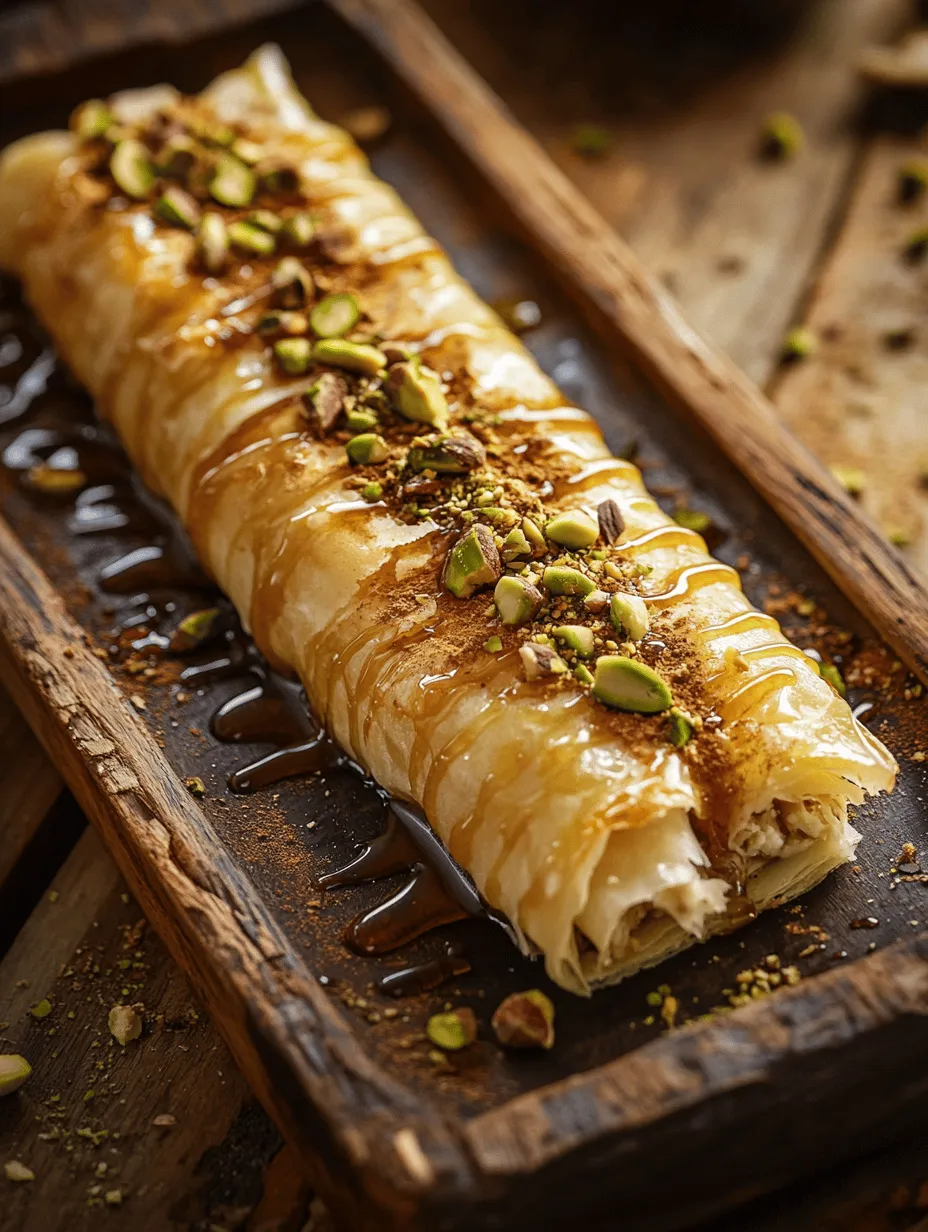Introduction
Shaabiyat Delights are a cherished dessert in Middle Eastern cuisine, celebrated for their unique blend of textures and flavors. This delightful treat consists of crispy phyllo pastry enveloping a creamy, rich filling, often highlighted by the warmth of spices and the sweetness of honey. Originating from various regions in the Middle East, Shaabiyat reflects the region’s culinary traditions, where sweets hold significant cultural importance. They are often served during festive occasions, family gatherings, and celebrations, symbolizing hospitality and joy.
The appeal of Shaabiyat Delights lies in their balance of textures. The thin, flaky layers of phyllo pastry contrast beautifully with the smooth, decadent filling, creating a delightful bite that is both satisfying and indulgent. The dish is not just a treat for the taste buds; it is a visual feast as well, showcasing layers that are golden and crispy, inviting you to indulge in their sweetness.
In Middle Eastern culture, sweets are an integral part of social life. They are shared among friends and family, served at weddings, and presented as gifts during holidays. The art of dessert-making is deeply rooted in tradition, with each recipe telling a story of the region’s history and the bonds between people. Shaabiyat Delights, with their rich flavors and beautiful presentation, embody the essence of these celebrations, making them a must-try for anyone looking to explore the culinary landscape of the Middle East.
Understanding the Ingredients
To create the perfect Shaabiyat Delights, you’ll need to gather several key ingredients that contribute to the dessert’s unique flavor and texture. Each component plays a significant role in crafting this Middle Eastern delight.
Phyllo Pastry
Phyllo pastry is a hallmark of many Middle Eastern desserts and is known for its light, flaky texture. Made from flour, water, and a bit of salt, this paper-thin pastry is layered to create a crispy outer shell that encases the filling. The key to success with phyllo is in the handling; it can dry out quickly if exposed to air, which is why keeping it covered with a damp cloth while working is essential. When baked, phyllo transforms into a golden-brown, crunchy exterior that perfectly complements the creamy filling inside.
Cheeses
The filling for Shaabiyat Delights typically features a combination of cheeses, with ricotta and Nabulsi cheese being popular choices. Ricotta offers a mild flavor and creamy texture, making it an excellent base for the filling. On the other hand, Nabulsi cheese—an Arabic cheese known for its slightly salty taste—adds depth and richness. The combination of these cheeses creates a harmonious blend that enhances the overall flavor profile of the dessert. The choice of cheese can vary based on availability and personal preference, allowing for some creativity in the kitchen.
Semolina
Semolina is another critical ingredient in the filling of Shaabiyat Delights. This coarse flour, made from durum wheat, adds richness and body to the mixture. When cooked, semolina absorbs flavors and creates a creamy consistency that binds the filling together. It also contributes a slight nuttiness, enhancing the overall taste experience. The careful balancing of semolina with the cheeses ensures that the filling is not only flavorful but also has the right texture to complement the crispy phyllo.
Nuts
Nuts play a vital role in Middle Eastern sweets, adding both flavor and texture. For Shaabiyat Delights, pistachios and almonds are popular choices. These nuts are often finely chopped and incorporated into the filling or used as a garnish on top of the baked dessert. The crunchiness of the nuts provides a delightful contrast to the creamy filling, while their rich flavor elevates the overall taste. Nuts also carry cultural significance in Middle Eastern cuisine, often symbolizing prosperity and abundance.
Honey
Honey is a quintessential ingredient in many Middle Eastern desserts, including Shaabiyat Delights. It lends a natural sweetness and a glossy finish that enhances the visual appeal of the dish. Beyond its flavor, honey has symbolic meanings in various cultures, often representing love and prosperity. When drizzled over the finished Shaabiyat, honey not only adds sweetness but also a fragrant aroma that invites you to take a bite. Its sticky texture helps to bind the layers together, making each piece enjoyable to eat.
Step-by-Step Guide to Making Shaabiyat Delights
Creating Shaabiyat Delights may seem daunting at first, but with the right guidance, you can master this exquisite dessert. Below is a detailed step-by-step guide to help you through the process, starting with preparing the filling.
Preparing the Filling
1. Mixing the Ingredients: Begin by combining your chosen cheeses in a large mixing bowl. If using ricotta, ensure it is well-drained to avoid excess moisture. Add in the semolina and any desired flavorings, such as a hint of orange blossom or rose water, to infuse the filling with aromatic notes. Use a spatula or fork to mix everything thoroughly until you achieve a smooth, creamy consistency.
2. Achieving the Right Texture: The filling should be thick enough to hold its shape but still creamy enough to provide a satisfying mouthfeel. Taste the mixture and adjust the flavors according to your preference, adding a pinch of salt or more honey if needed.
3. Adding Nuts: Fold in the finely chopped nuts, ensuring they are evenly distributed throughout the filling. This will add a delightful crunch to every bite, enhancing the overall texture of the Shaabiyat Delights.
Working with Phyllo Pastry
4. Preparing the Phyllo: Take your phyllo pastry out of the packaging and carefully unroll it. Lay it flat on a clean, dry surface and cover it with a damp cloth to prevent it from drying out while you work. Phyllo can be fragile, so handle it gently.
5. Layering the Pastry: To create a robust outer layer, take two sheets of phyllo and lay them one on top of the other. Lightly brush the top sheet with melted butter or oil, which will help achieve that golden, crispy texture once baked. Repeat this step with additional sheets, layering them as needed for a thicker pastry base.
6. Filling the Pastry: Once you have your layered phyllo ready, scoop a portion of the cheese and semolina filling onto one end of the pastry. Ensure not to overfill, as this can lead to messy rolls. Shape the filling into a log or a line along the edge of the pastry, leaving enough space at the edges for folding.
7. Forming the Rolls: Carefully roll the phyllo over the filling, tucking in the sides as you go to create a secure roll. The goal is to maintain a tight shape while preventing the filling from spilling out. If desired, you can create different shapes—such as coils or straight rolls—depending on your aesthetic preference.
8. Sealing the Rolls: Once you’ve shaped your rolls, brush the outer layer with more butter or oil to ensure they bake to a beautiful golden color. Place the formed rolls on a baking tray lined with parchment paper, allowing space between each piece for even cooking.
9. Baking: Preheat your oven to an appropriate temperature, typically around 375°F (190°C). Bake the Shaabiyat Delights until they are golden brown and crispy, usually about 20-25 minutes. Keep an eye on them to prevent burning, as oven temperatures can vary.
Techniques to Prevent the Pastry from Drying Out
While working with phyllo pastry, it’s crucial to maintain its moisture to ensure it remains pliable and doesn’t crack. Here are some tips:
– Always keep unused sheets covered with a damp cloth.
– Prepare your filling ahead of time so you can assemble quickly.
– Work in batches, covering the rest of the phyllo while you roll out the first few pieces.
Variations in Shaping
When it comes to shaping Shaabiyat Delights, there are a couple of options to consider:
– Coils: Rolling the phyllo into coils creates a visually stunning dessert that showcases the layers of pastry. This method also allows for more filling to be included in each piece.
– Straight Rolls: Alternatively, you can opt for traditional straight rolls, which are easier to cut and serve. These can be more uniform in size, making them ideal for larger gatherings.
The choice of shape can be influenced by your personal preference, the occasion, or simply for the sake of variety. Each shape offers a unique presentation, making the dessert even more appealing.
By following these steps and tips, you’ll be well on your way to creating delicious Shaabiyat Delights that are sure to impress your family and friends. The combination of creamy filling, flaky pastry, and the sweet drizzle of honey will transport you to the heart of the Middle East, celebrating the rich culinary heritage of this vibrant region. Enjoy the process of making this delightful treat, and savor every bite of your homemade Shaabiyat Delights.

Baking the Shaabiyat Delights
Once your dough is prepared and the filling is ready, it’s time to turn your attention to the oven. Preheating it to the ideal temperature is crucial for achieving those perfect Shaabiyat Delights. Set your oven to 375°F (190°C). This temperature is optimal for baking, allowing the pastries to rise beautifully while developing a golden-brown color.
When placing your filled pastries in the oven, keep an eye on them throughout the baking process. Generally, they will need about 25-30 minutes. The key indicator that they are ready is their color; you want them to be a rich, golden brown. Monitoring the baking process is essential, as too little time could leave them doughy, while too much could lead to dryness. If your oven has hot spots, you might want to rotate the baking tray halfway through to ensure even cooking.
As the pastries bake, the aroma of warm dough and sweet filling will fill your kitchen, creating an inviting atmosphere. This is the time to prepare for the next step: the honey syrup.
Preparing the Honey Syrup
The syrup is what elevates the Shaabiyat Delights from ordinary pastries to an extraordinary treat. To make the honey syrup, combine 1 cup of honey with 1/2 cup of water in a small saucepan. You can also add a splash of lemon juice to balance the sweetness and enhance the flavor profile. Heat the mixture over medium heat, stirring occasionally until it comes to a gentle boil. Once it reaches a boil, reduce the heat and let it simmer for about 5-10 minutes.
For extra flavor, consider adding spices such as a pinch of cinnamon or a few cardamom pods to the syrup while it simmers. These spices are commonly used in Middle Eastern desserts and will infuse your syrup with warm, aromatic notes. After simmering, remove the syrup from heat and let it cool slightly before drizzling it over your baked Shaabiyat Delights.
The honey syrup plays a vital role in Middle Eastern desserts, not just for sweetness but also for moisture. It seeps into the pastries, giving them a luscious texture and a distinct flavor that complements the nutty filling. Once you pour the syrup over the warm pastries, allow them to absorb the syrup for a few minutes before serving.
Serving Suggestions
When it comes to serving your Shaabiyat Delights, presentation can enhance the overall experience. Arrange the pastries on a decorative platter, and consider garnishing them with finely chopped nuts—such as pistachios or almonds—sprinkled over the top. This not only adds a delightful crunch but also enhances the visual appeal.
A dusting of cinnamon can elevate the aesthetics further and provide an aromatic hint that will entice your guests. Additionally, you might serve the pastries alongside traditional Middle Eastern beverages, such as mint tea or Arabic coffee, which complement the sweet flavors beautifully. These drinks not only balance the dish but also add to the authenticity of the experience.
Cultural Significance and Variations
Shaabiyat Delights are not just a treat; they are steeped in cultural significance within Middle Eastern traditions. Desserts like these often symbolize hospitality and generosity, traditionally served during festive occasions and gatherings. In many families, preparing such sweets is a cherished ritual that brings everyone together.
Across the Middle East, variations of Shaabiyat exist, each showcasing local ingredients and culinary techniques. For instance, in Lebanon, you might find a version filled with a blend of nuts and flavored with rose water, while in Egypt, the filling may incorporate dates or figs. These regional spins reflect the rich tapestry of Middle Eastern cuisine and its ability to adapt flavors to suit local tastes.
Culturally, such desserts are often prepared during Ramadan, weddings, and other celebrations, signifying joy and festivity. Sharing these treats can foster a sense of community and connection among family and friends.
Nutritional Insights
While indulging in Shaabiyat Delights, it’s essential to consider their nutritional aspects. Each pastry is rich in carbohydrates due to the dough and filling, along with natural sugars from the honey syrup. A typical serving of two pastries contains approximately 250-300 calories. While these treats are delicious, moderation is key to enjoying them as part of a balanced diet.
If you’re looking to lighten the recipe, consider reducing the amount of honey in the syrup or experimenting with whole wheat flour for a healthier dough option. Additionally, serving smaller portions can help maintain a balance between indulgence and nutrition, allowing you to enjoy the sweet richness without overindulging.
Conclusion
Making Shaabiyat Delights is an enjoyable and rewarding experience that combines culinary art with rich cultural heritage. These pastries, with their flaky pastry and sweet, nutty filling, embody the essence of Middle Eastern desserts. Whether you’re preparing them for a special occasion or simply to share with family and friends, the satisfaction of creating and sharing these treats is immeasurable.
Exploring Middle Eastern cuisine through this accessible recipe offers an opportunity to connect with the culture and traditions behind it. So roll up your sleeves, gather your ingredients, and embark on a culinary adventure that promises to delight not just your taste buds, but also the hearts of those around you. Enjoy the process, and savor every bite of your homemade Shaabiyat Delights.



